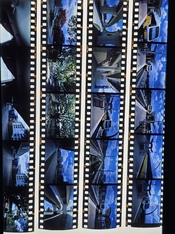Using an online OCR and a document translator, I managed to extract 2 pages out of Shadrin's scanned book that was shared before by
@LeoniD . I am attaching my PDF. I was interested in processing errors, that's why I spent time only on these pages.
This is also important to note:
"
Citrazinic acid is one of the key reagents of the E-6 process. The reason is that
by the technology for the production of color reversal photographic films the purple dye component is introduced into the material in
excess. This is explained by complex optical reasons. If we
treat the photographic film with a solution of color developer that does not contain
pressing citrazic acid, the image balance will be greatly
shifted to the purple side, due to the excess formation of magenta dye. Even a pinkish fog will appear in light areas.
Other dyes are formed only in slight excess.
It becomes obvious that the purple component
requires lower color developing agent concentration than other components
. This means that, in one solution
the concentration of CD-3 should be both high and low. Satisfying this seemingly absurd requirement
achieved by introducing citrazinic acid into the solution. Mechanism
here's the next one. At the moment of merging parts “A” and “B” of the developer
citrazinic acid interacts with color developing agent and forms a complex colored complex (by the way,
This is why the solution takes on a tea color). Concentration of the
acid is selected so that not the entire amount of CD-3 in solution participates in the formation of the complex, and some of it remains free. This way
the content of free CD decreases approximately 1.5 times.
Adding more citrazinic acid to the prepared
developer is useless: the reagent will not react with the color
developing substance.
Cyan, yellow and other components easily destroy the bond of
CD-3 with citrazic acid and form a dye. These components are
practically “indifferent” whether CD-3 is bound into the complex or not."
from what I have learned from Stefan Lange, a guy who reverse engineered the E6 formulas here https://www.photrio.com/forum/threads/e6-homebrew-chromebrew-warnig-longer-than-assumend.32721/ (starting from patent formulas of Fuji and Derek Watkins) the yellow-blue axis is controlled by the amount of potassium iodide while the magenta-green axis is controlled by the color developer pH [higher -> more green, lower -> more magenta]. Indeed, the pH can be raised with sodium hydroxide and lowered with acetic acid, but that's just for magenta-green. I think the yellow tint is acquired by changing the iodide content














